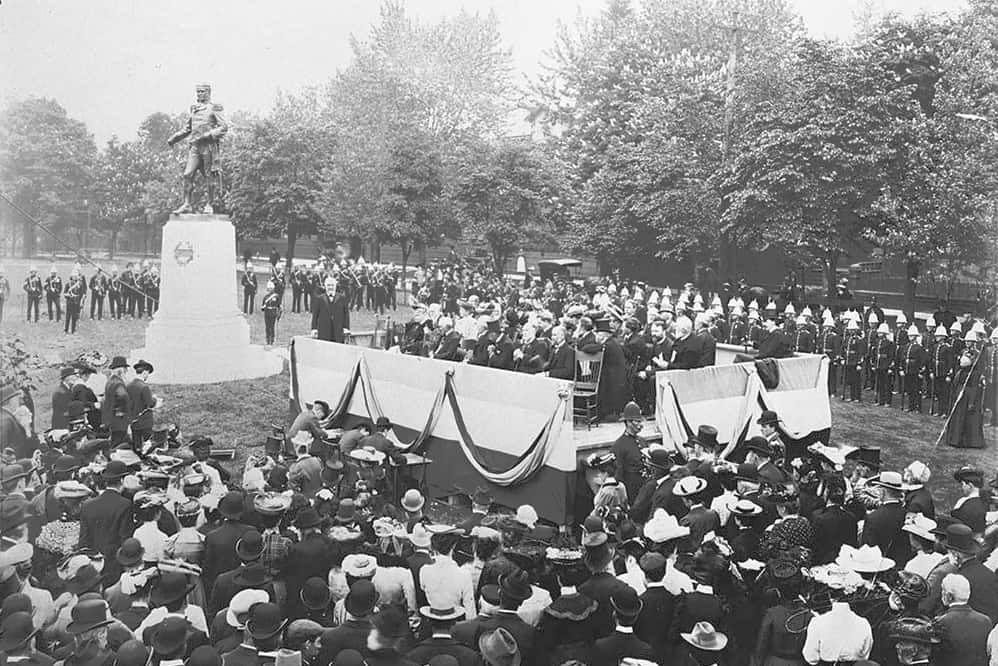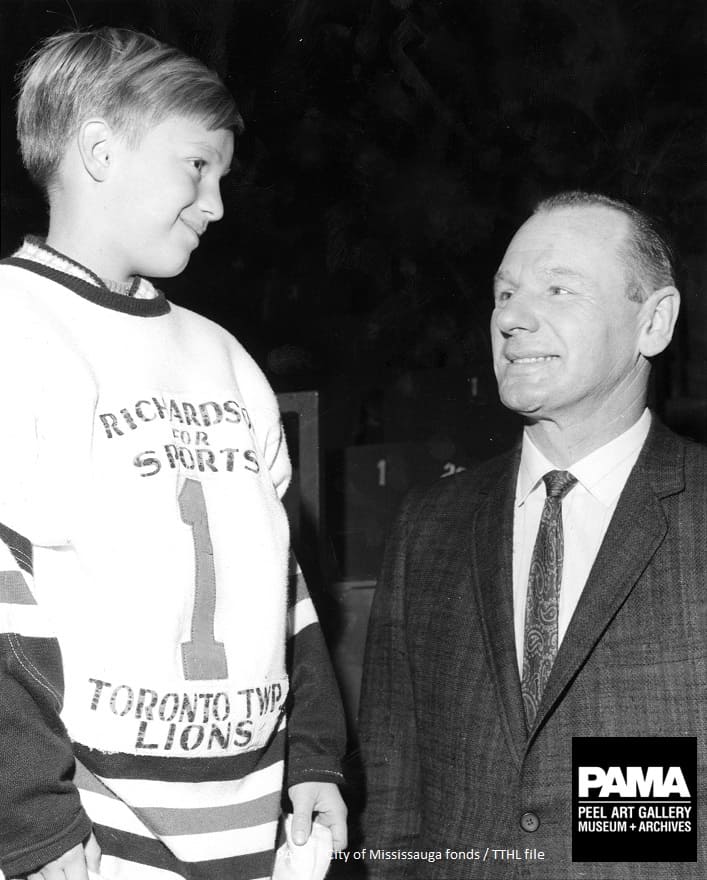What do you think of Mississauga being named Sheridan instead?
Published October 15, 2022 at 10:30 pm

Did you know that from 1806 to 1968, the majority of Mississauga was known as “Toronto Township” and there was another choice for the town name?
Rewind to Samuel de Champlain’s explorations of this area in 1615, and you’ll find maps using “tkaronto”, a Kanien’kehá:ka (Mohawk) word, to mark a waterway up at Lake Simcoe, past Barrie.
Over the next years, variants of “Toronto” were used for a wetland on Lake Simcoe, Lake Simcoe itself, a canoe route along the Humber River, and even the Humber River itself (Rivière Taronto).
Eventually, a fort named Toronto was established on what are now the grounds of Exhibition Place. Also known as Fort Rouillé, it was the earliest permanent non-Aboriginal settlement in the area.

An early map marking Lake Simcoe as Lac de Taronto.
The first Lieutenant Governor of Upper Canada was a British Army officer by the name of John Graves Simcoe. (The August Civic Holiday is known as Simcoe Day in Toronto.) He set up Ontario’s first courts of law, trial by jury, and modern land ownership.
Under his direction, Upper Canada was the first area of the British Empire to abolish slavery in 1793. (It wasn’t until 1834 that the rest of the British Empire abolished slavery, 29 years before the United States.)
The founding of the Town of York
According to an account of the story by Peel warden and Toronto Township reeve Mary Fix, Simcoe was partial to the name Toronto for the new capital of Upper Canada.
His associates, though, were cold to the option, preferring to use British names as aspirational goals for the new colony. When the community was finally laid, a ceremony was held on August 27, 1793, to announce the name of “York” for this “temporary” capital of Upper Canada. (Similarly, the settlement of Niagara was renamed Newark, and Cataraqui became Kingston.)
In the words of an Irish map-maker working in Canada, “It is to be lamented that the Indian names, so grand and sonorous, should ever have been changed for others.”

Since 1903, Simcoe has stood in Queen’s Park, watching over Toronto. City of Toronto Archives, fonds 1568, item 507.
York goes for the steal
A little west, what became Toronto Township was being drawn out. Following the “Mississauga purchase” of land from the local Aboriginals, the name Toronto was given “legally and officially” to the area in 1805. (Alexander Grant, a member of the Executive and Legislative Council of Upper Canada wanted to call two other Townships “Alexander” and “Grant”, but was overruled.)
It’s thought that Grant would have been familiar with the name from Fort Toronto, and perhaps even Simcoe’s preferences, when he named the township. Surveying of the land, which would allow settlement, began in 1806, the year Simcoe died.
As such, the Township of Toronto was the first municipality in the world to use the name “Toronto”.
 A surveyor’s map of Toronto Township, drawn between 1818 and 1819. Archives of Ontario.
A surveyor’s map of Toronto Township, drawn between 1818 and 1819. Archives of Ontario.
When the City of York wanted to incorporate in 1834, they considered returning to Simcoe’s first choice.
The speaker of the council expressed his support, receiving cheers of the statement that “this city will be the only City of Toronto in the world”, seemingly oblivious to the fact there was a nearby rural community with the name.
Despite the opposition of prominent landholding families like the Jarvises, for whom Jarvis Street is named, the name was adopted that year.
Much of what now is the GTA was the “Home District” of Upper Canada, in this early period. York’s request for incorporation as the City of Toronto was apparently not met with resistance when it was taken to the Home District Courts, according to Mary Fix in 1967.
According to the “Settlement History of Peel” (1977), when residents found out, there was “considerable consternation and anger” against the City of Toronto.
Regardless, for the next 133 years, there’d be two Torontos: the City of Toronto and Toronto Township.
Toronto lives a double life
Toronto Township would grow north of Eglinton, and shed Port Credit and Streetsville once each were large enough to be independent villages. While places like Meadowvale and Lakeview are referred to as historic villages, in terms of government, they were essentially no different than a modern subdivision.

Planning for early modern Mississauga was done by the Toronto Township planning board. PAMA/City of MIssissauga fonds
You paid your taxes to Toronto Township, and in turn there was a Toronto Township Council, Toronto Township Fire Department, Toronto Township Hydro, Toronto Township Police, et cetera. Even independent organizations bore the name, like the Toronto Township Hockey League.

Election material from the 1894 municipal election. While Henry’s ward included Meadowvale, he was a Toronto Township councillor. PAMA/RPA ephemera collection

Toronto Maple Leafs goalie Johnny Bower doing an appearance for the Toronto Township Hockey League. Notice the team is named the “Toronto Township Lions”.
While there was never a legal Village of Cooksville, residents of central Toronto Township would have their mail processed at the Cooksville post office. Someone living on Dundas Street, so far east of Cooksville that they were almost in Etobicoke, would still write their return address on letters as Cooksville.
Over the decades, Mississauga lost land in its north to Brampton, added Malton from Toronto Gore Township, and gained land on the west from Halton. The City of Toronto itself gradually started eating up surrounding communities like Yorkville, Riverdale, and Swansea.
Asking residents
Fast forward to 1965, and the Township of Toronto is full of suburban development in neighbourhoods like Applewood, Sheridan Park, and Mineola. It was clear that the area couldn’t keep calling itself a “Township”, a designation meant for farming communities. Stuck between the Town of Streetsville and the Town of Port Credit, the township also needed to become a town.
But what name would it choose? Pick an existing community name, like Malton or Cooksville, and face the wrath of residents in the snubbed communities?
Or they could choose the Indigenous peoples who first owned the land, the Mississaugas. A newspaper, the Mississauga Times, and the differently spelled Mississaugua Golf and County Club both used the name.
It took quite a lot of back and forth amongst the citizens and politicians over a number of years, but eventually voters decided on the current name of Mississauga.
According to the Mississaugas of the Credit First Nation website on December 9, 1967 the Toronto Township went to the polls to select a name for the town that would be newly born on January 1, 1968.
Voters could choose between the two possible town names of “Mississauga” or “Sheridan”. Mississauga ended up being the voters choice by a wide margin of 11, 796 votes to 4,311.
While it’s been decades since Toronto Township existed, take a look at your property taxes. Unless you live in Malton, or west of Winston Churchill, the land your house is on is described by its “Toronto Township” lot number.
Conceivably, it still will be even a century from now.
INsauga's Editorial Standards and Policies



